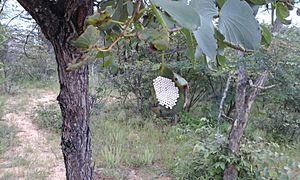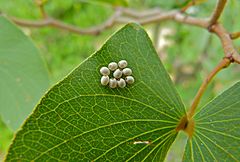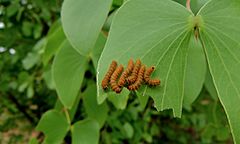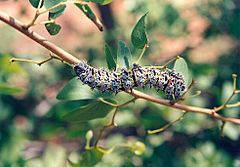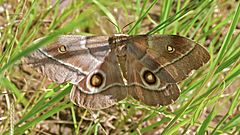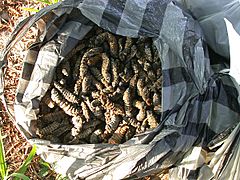Mopane worm facts for kids
Quick facts for kids Mopane worm |
|
|---|---|
 |
|
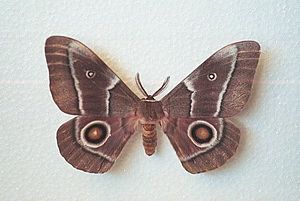 |
|
| Caterpillar in a mopane tree, and male imago (note the feathered antennae) | |
| Scientific classification |
The mopane worm is actually a large caterpillar. It grows into a type of emperor moth called Gonimbrasia belina. This moth lives in the warmer parts of southern Africa.
The caterpillar is famous because it is edible, meaning people can eat it! It's also known by names like madora, amacimbi, or masontja. Mopane worms mainly eat the leaves of the mopane tree. They are a very important source of protein for many people in southern Africa. A scientist named John O. Westwood first described this species in 1849.
Contents
What is a Mopane Worm?
The mopane worm gets its English name because it usually lives on the mopane tree. People in different countries have their own names for these caterpillars:
- In Botswana, they are called mahonja (in Kalanga) or phane (in Tswana).
- In South Africa, some names are mašotša or mashonzha.
- In Zambia, they might be called muyaya or finkubala.
- In Zimbabwe, common names include macimbi or madora.
- In Namibia, they are known as omagungu or oshuungu.
- In the Democratic Republic of the Congo, they are called mingolo.
Sometimes, the scientific name is written as Imbrasia belina instead of Gonimbrasia belina.
How to Identify Mopane Worms and Moths
The adult moths are quite large, with wings that can spread up to 120 millimeters (about 4.7 inches). Their wings can be fawn (light brown), green, brown, or red. They have two black and white stripes that surround special eyespots. Each back wing also has an orange eyespot. Male moths have feathery antennae, which help them find a mate.
The caterpillars (larvae) are black. They have small, round scales that look like whitish-green and yellow stripes. They also have short black or reddish spines covered in tiny white hairs.
Mopane Worm Habitat and Diet
Mopane worms are found in many places. They are very common in semi-desert areas, bushveld, and grasslands.
While they mostly eat mopane leaves, mopane worms can also eat leaves from other plants. These include Carissa grandiflora, Diospyros, Ficus, Rhus, Sclerocarya caffra, Terminalia, and Trema. Sometimes, a lot of mopane worms can eat so many leaves that they strip the trees bare. This can reduce food for other animals. However, the trees usually recover quickly.
Mopane Worm Life Cycle
The life cycle of a mopane worm starts when it hatches from an egg in the summer. After hatching, the tiny larva (caterpillar) immediately begins to eat leaves around it. As it grows, the caterpillar sheds its skin four times. These stages are called instars. After the fourth shed, the mopane worm is ready to be harvested.
If the caterpillar is not harvested, it burrows underground. There, it enters the pupa stage, where it transforms into an adult moth. This transformation takes about 6 to 7 months, happening over the winter. The adult moth then emerges at the start of summer, usually in November or December.
Adult moths live for only three to four days. During this short time, they mate and lay their eggs, starting the cycle all over again.
Predators of Mopane Worms
Mopane worms and their eggs face many dangers. They can be eaten by various predators or get sick from diseases. More than 40% of mopane worm eggs are often attacked by parasites. The caterpillars themselves can get a virus that causes many of them to die.
The main predators of mopane worms are birds and humans. Both rely on these caterpillars as a source of food.
Mopane Worms as Food
Mopane worms are collected by hand in the wild, often by women and children. In wild areas, the caterpillars are usually free for anyone to pick. However, if they are near a house, it's polite to ask permission. People might mark trees with bark to show ownership, or even move young caterpillars closer to their homes.
Once a caterpillar is picked, its tail end is pinched to break the insides. Then, the picker squeezes it like a tube of toothpaste to push out the slimy, green contents of its gut.
Preserving Mopane Worms
The traditional way to preserve mopane worms is to boil them with a lot of salt after washing them. No extra water is added during boiling. After boiling, they are dried in the sun or smoked. Smoking gives them extra flavor.
Industrially, mopane worms are often canned, usually in salty water (brine). You can find cans of mopane worms in rural supermarkets and markets across southern Africa.
Eating Mopane Worms
Dried mopane worms can be eaten raw as a crunchy snack. In Botswana, people usually don't eat the head. Another way to eat them is to soak them in water to make them soft again. Then, they can be fried until crispy, or cooked with onion, tomatoes, and spices. They are often served with pap or sadza, which are types of thick porridge.
The inside of the worm is yellow. It might still have small pieces of dried leaves from its gut, which are not harmful. These dried leaves can taste a bit like tea leaves. Dried mopane worms are also often canned in tomato sauce or chili sauce to add more flavor.
In 2015, a team from Cornell University won third place in a global business challenge. They showed how turning mopane worm protein into food could be good for the economy and nutrition.
Mopane Worm Farming and Economy
Collecting and selling mopane worms is a huge business in southern Africa, worth millions of rand. The main countries involved are Botswana, Namibia, South Africa (especially Limpopo Province and Mpumalanga), and Zimbabwe. Usually, the caterpillars are not raised on farms. Instead, they are collected from where they grow naturally.
The mopane worm is one of the most important insects for the economy in this region. In the 1990s, hundreds of tons were sent out from Botswana and South Africa every year. It's thought that South Africa alone trades about 1.6 million kilograms of mopane worms each year. Botswana's part in this industry brings in about $8 million annually.
Mopane worms are a profitable harvest. Just three kilograms of mopane leaves can produce one kilogram of mopane worms. In comparison, raising cattle needs ten kilograms of feed to produce one kilogram of beef. This makes mopane worms a cheap, easy-to-manage, and high-protein food source.
Harvesting Mopane Worms
In the past, mopane worms were harvested mainly for families to eat themselves (subsistence farming). Because they only appear at certain times of the year, they are not a year-round food. However, traditional mopane worm harvesting is now becoming more focused on selling them commercially.
Since the 1950s, commercial harvesting methods have been used, especially in South Africa. Collectors might organize teams of hundreds of people to pick the caterpillars by hand from the trees. Then, the worms are put into bags, weighed, and sent for processing. Landowners where mopane worms are found might charge harvesters large fees to enter. This benefits both the commercial harvester and the farmer. However, it can sometimes harm local communities who used to rely on the caterpillars for food and seasonal income.
Sustainability of Mopane Worms
Mopane worms are a big part of the local rural economy. This attracts many people who want to earn money by selling them. This can lead to overharvesting, meaning too many worms are collected. This results in fewer mopane worms the next year. In some areas, farmers and communities are working together to find a balance. They want to ensure they get the most worms each year without harming future harvests.
Concerns about Competition
When mopane worms are present, they can eat up to 90% of the leaves in mopane woodlands. Farm animals that are fenced in might depend on mopane trees and other trees that caterpillars like to eat. Some farmers see mopane worms as competition for their livestock. They might try to get rid of the "pest" using insecticides. However, the caterpillar season is short. The trees quickly grow new, tender leaves that animals prefer. This problem can be managed by working with local caterpillar harvesters. They can control the worms by collecting them.
Bringing Mopane Worms Back
Some areas that once had many mopane worms now have very few. This is due to too much harvesting and not using sustainable methods. For example, in Nkayi District, Zimbabwe, mopane woodlands used to produce many worms, but harvests have dropped a lot.
One idea to bring the worms back is to re-colonize these areas. The adult moth only lives for three to four days to mate and lay eggs. This means there's a very small window to move them. If this stage is successful, local farmers and communities would need to agree not to harvest the caterpillars for a few years. This would help the area repopulate. Then, a sustainable harvest could be created for the future.
Farming Mopane Worms
People in the business have thought about farming mopane worms, similar to how silkworms are raised. This would make the industry less affected by things like climate change, drought, or other factors that can hurt a wild harvest. For small-scale farming to work, especially for the poorest people, the cost of raising the worms would need to be similar to the cost of wild or dried worms in the market.
Processing Mopane Worms
A Mopani Processing center has been built in Dzumeri, about 34 kilometers from Giyani. The Council of Scientific and Industrial Research (CSIR) provided the money for this center. When fully working, the center should be able to produce large amounts of different mopani snacks and even mopani polony (a type of sausage).
Images for kids
See also
 In Spanish: Gonimbrasia belina para niños
In Spanish: Gonimbrasia belina para niños


